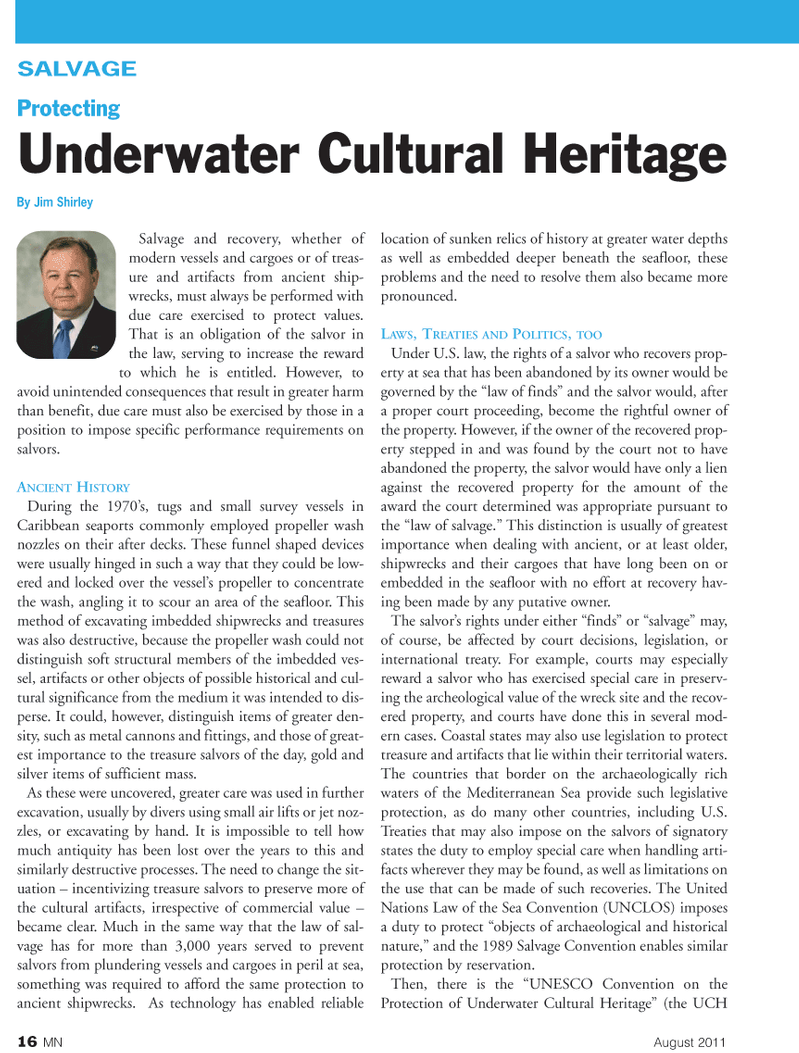
Page 16: of Marine News Magazine (August 2011)
Marine Salvage & Recovery Edition
Read this page in Pdf, Flash or Html5 edition of August 2011 Marine News Magazine
16MNAugust 2011SALVAGE Salvage and recovery, whether of modern vessels and cargoes or of treas- ure and artifacts from ancient ship- wrecks, must always be performed with due care exercised to protect values. That is an obligation of the salvor in the law, serving to increase the reward to which he is entitled. However, to avoid unintended consequences that result in greater harm than benefit, due care must also be exercised by those in a position to impose specific performance requirements on salvors. ANCIENTHISTORY During the 1970s, tugs and small survey vessels in Caribbean seaports commonly employed propeller wash nozzles on their after decks. These funnel shaped devices were usually hinged in such a way that they could be low- ered and locked over the vessels propeller to concentrate the wash, angling it to scour an area of the seafloor. This method of excavating imbedded shipwrecks and treasures was also destructive, because the propeller wash could not distinguish soft structural members of the imbedded ves- sel, artifacts or other objects of possible historical and cul- tural significance from the medium it was intended to dis- perse. It could, however, distinguish items of greater den- sity, such as metal cannons and fittings, and those of great- est importance to the treasure salvors of the day, gold and silver items of sufficient mass. As these were uncovered, greater care was used in further excavation, usually by divers using small air lifts or jet noz- zles, or excavating by hand. It is impossible to tell how much antiquity has been lost over the years to this and similarly destructive processes. The need to change the sit- uation ? incentivizing treasure salvors to preserve more of the cultural artifacts, irrespective of commercial value ? became clear. Much in the same way that the law of sal- vage has for more than 3,000 years served to prevent salvors from plundering vessels and cargoes in peril at sea, something was required to afford the same protection to ancient shipwrecks. As technology has enabled reliable location of sunken relics of history at greater water depths as well as embedded deeper beneath the seafloor, these problems and the need to resolve them also became more pronounced. LAWS , TREATIESAND POLITICS, TOO Under U.S. law, the rights of a salvor who recovers prop- erty at sea that has been abandoned by its owner would be governed by the law of finds? and the salvor would, after a proper court proceeding, become the rightful owner of the property. However, if the owner of the recovered prop- erty stepped in and was found by the court not to have abandoned the property, the salvor would have only a lien against the recovered property for the amount of the award the court determined was appropriate pursuant to the law of salvage.? This distinction is usually of greatest importance when dealing with ancient, or at least older, shipwrecks and their cargoes that have long been on or embedded in the seafloor with no effort at recovery hav- ing been made by any putative owner. The salvors rights under either finds? or salvage? may, of course, be affected by court decisions, legislation, or international treaty. For example, courts may especially reward a salvor who has exercised special care in preserv- ing the archeological value of the wreck site and the recov- ered property, and courts have done this in several mod- ern cases. Coastal states may also use legislation to protect treasure and artifacts that lie within their territorial waters. The countries that border on the archaeologically rich waters of the Mediterranean Sea provide such legislative protection, as do many other countries, including U.S. Treaties that may also impose on the salvors of signatory states the duty to employ special care when handling arti- facts wherever they may be found, as well as limitations on the use that can be made of such recoveries. The United Nations Law of the Sea Convention (UNCLOS) imposes a duty to protect objects of archaeological and historical nature,? and the 1989 Salvage Convention enables similar protection by reservation. Then, there is the UNESCO Convention on the Protection of Underwater Cultural Heritage? (the UCH Protecting Underwater Cultural HeritageBy Jim Shirley

 15
15

 17
17
